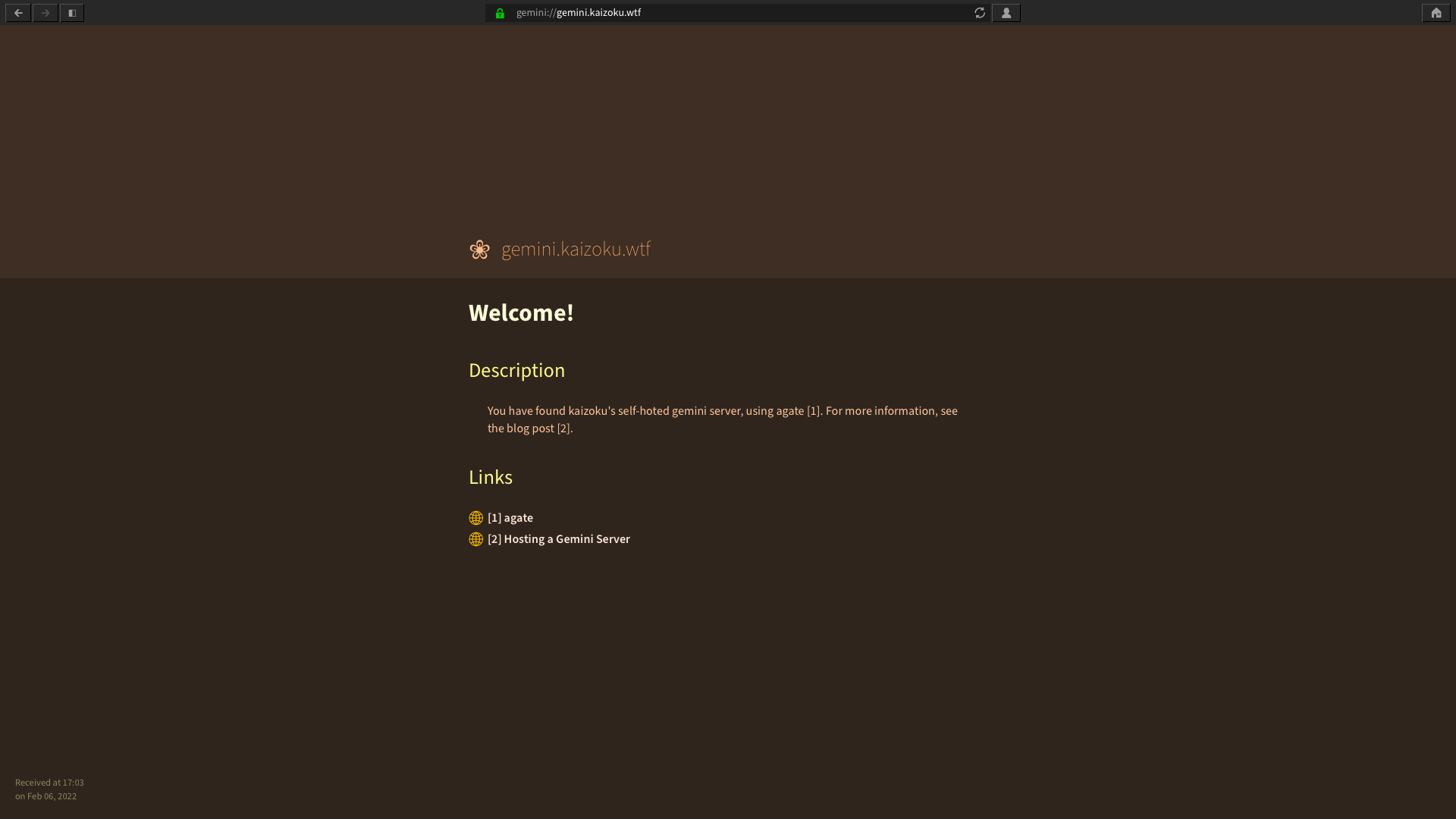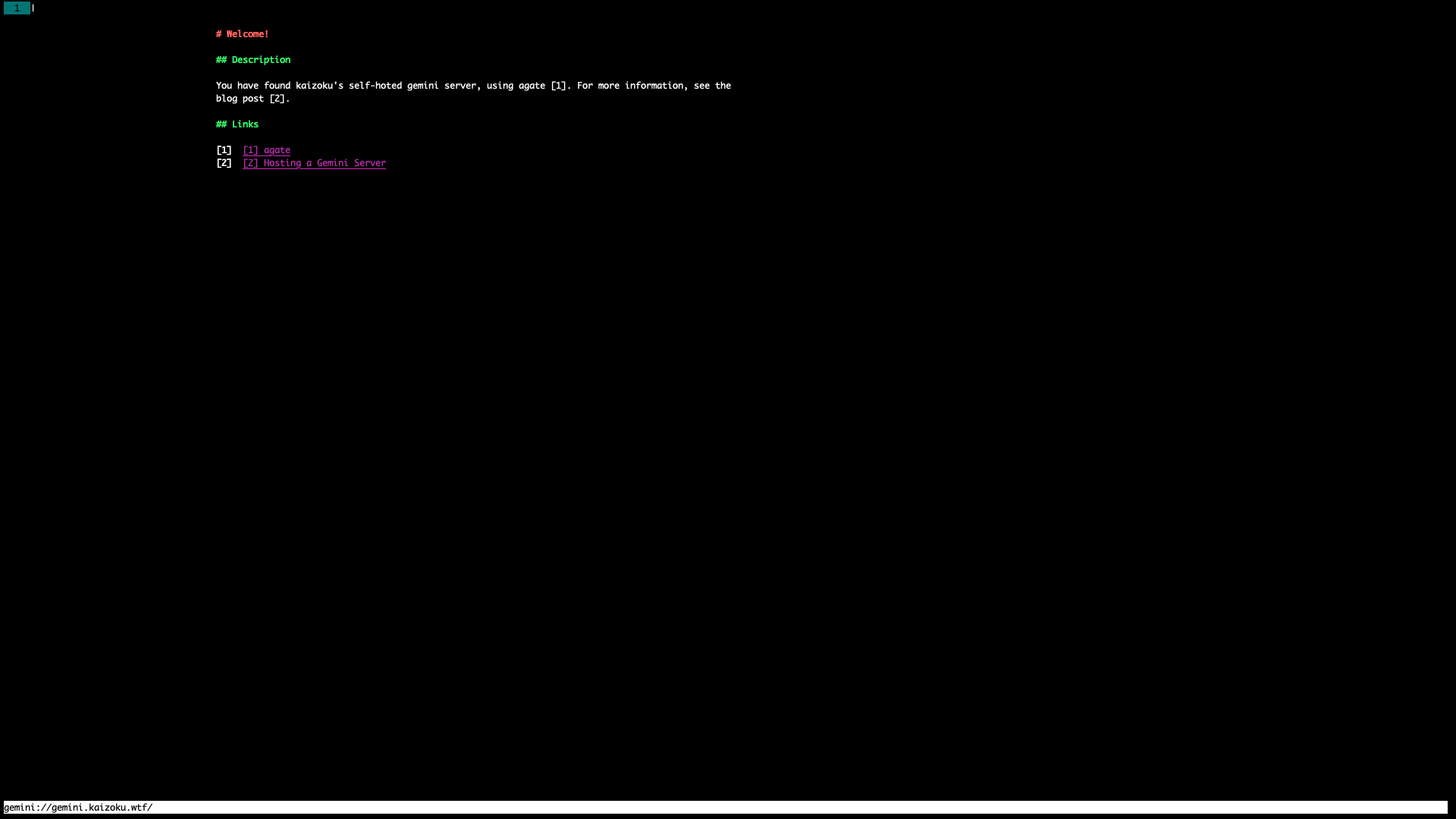diff options
Diffstat (limited to 'content/blog/2021-04-17-gemini-server.md')
| -rw-r--r-- | content/blog/2021-04-17-gemini-server.md | 165 |
1 files changed, 165 insertions, 0 deletions
diff --git a/content/blog/2021-04-17-gemini-server.md b/content/blog/2021-04-17-gemini-server.md new file mode 100644 index 0000000..7b4aafe --- /dev/null +++ b/content/blog/2021-04-17-gemini-server.md @@ -0,0 +1,165 @@ ++++ +date = 2021-04-17 +title = "Hosting a Gemini Server" +description = "" +draft = false ++++ + +# Similar Article Available + +To read more about Gemini and ways to test out this new protocol without +your own server, see my previous post [Launching a Gemini +Capsule](../launching-a-gemini-capsule/). + +# Preparation + +This guide assumes you have access to a server accessible to the world +through a public IP address and that you own a domain name used for this +Gemini capsule. + +# Getting Started with Agate + +We are going to use [Agate](https://github.com/mbrubeck/agate) for this +tutorial. This is a basic Gemini server written in Rust. It takes very +little time and maintenance to get it running. + +# Install Dependencies + +First, you will need to install the Rust package for your system. On +Ubuntu, use the following commands (remember to use `sudo` if +you are not the root user). The Rust installation will give you options +to customize the installation; I used the default installation options. + +```sh +sudo apt update && sudo apt upgrade -y +curl https://sh.rustup.rs -sSf | sh +``` + +Remember to configure your shell with the new configuration: + +```sh +source $HOME/.cargo/env +``` + +Before we install agate, make sure you have the `gcc` package +installed: + +```sh +sudo apt install gcc +``` + +Next, you\'ll need to install the agate executable with Rust\'s Cargo +package maintainer: + +```sh +cargo install agate +``` + +# Create Symlinks + +Once Cargo has finished installing all the required packages, symlink +the executable to your \$PATH. + +```sh +sudo ln -s $HOME/.cargo/bin/agate /usr/local/bin/agate +``` + +# Using Agate\'s Built-In Installation Tool + +If you\'re running Ubuntu or Debian, use the Debian installation script +found in Agate\'s GitHub repository, under the `tools/debian` +folder. + +```sh +git clone https://github.com/mbrubeck/agate +cd agate/tools/debian +sudo ./install.sh +``` + +# Configure the Gemini Service + +We have a little more to do, but since this script tries to immediately +run the service, it will likely fail with an exit code. Let\'s add our +finishing touches. Edit the following file and replace the hostname with +your desired URL. You can also change the directory where content will +be served. + +```sh +sudo nano /etc/systemd/system/gemini.service +``` + +```sh +# Edit these lines to whatever you want - see the next code block for my personal configuration. +WorkingDirectory=/srv/gemini +ExecStart=agate --hostname $(uname -n) --lang en +``` + +This is my personal config: + +```sh +WorkingDirectory=/var/gemini/ +ExecStart=agate --hostname gemini.example.com --lang en +``` + +Since we\'ve altered the systemd configuration files, we have to reload +the daemon. Let\'s do that, restart our service, and check its status. + +```sh +sudo systemctl daemon-reload +sudo systemctl restart gemini.service +sudo systemctl status gemini.service +``` + +# Fixing Systemd Errors + +If you\'re still getting errors, the installation process may not have +properly enabled the gemini service. Fix it with the following commands. + +```sh +sudo systemctl enable gemini.service +sudo systemctl restart gemini.service +sudo systemctl status gemini.service +``` + +# Firewall Rules + +Great! Our server is now functional and running. The first consideration +now is that you need to be able to access port 1965 on the server. If +you have a firewall enabled, you\'ll need to open that port up. + +```sh +sudo ufw allow 1965 +sudo ufw reload +``` + +# Creating Content + +Let\'s create the Gemini capsule. Note that wherever you set the +WorkingDirectory variable to earlier, Agate will expect you to put your +Gemini capsule contents in a sub-folder called \"content.\" So, I place +my files in \"/var/gmi/content.\" I\'m going to create that folder now +and put a file in there. + +```sh +sudo mkdir /var/gemini/content +sudo nano /var/gemini/content/index.gmi +``` + +You can put whatever you want in the \"index.gmi\" file, just make sure +it\'s valid Gemtext. + +# The Results + +Here are some screenshots of the Gemini page I just created in the +[Lagrange](https://gmi.skyjake.fi/lagrange/) browser and the +[amfora](https://github.com/makeworld-the-better-one/amfora) browser. + + + +*Lagrange* + + + +*Amfora* |
